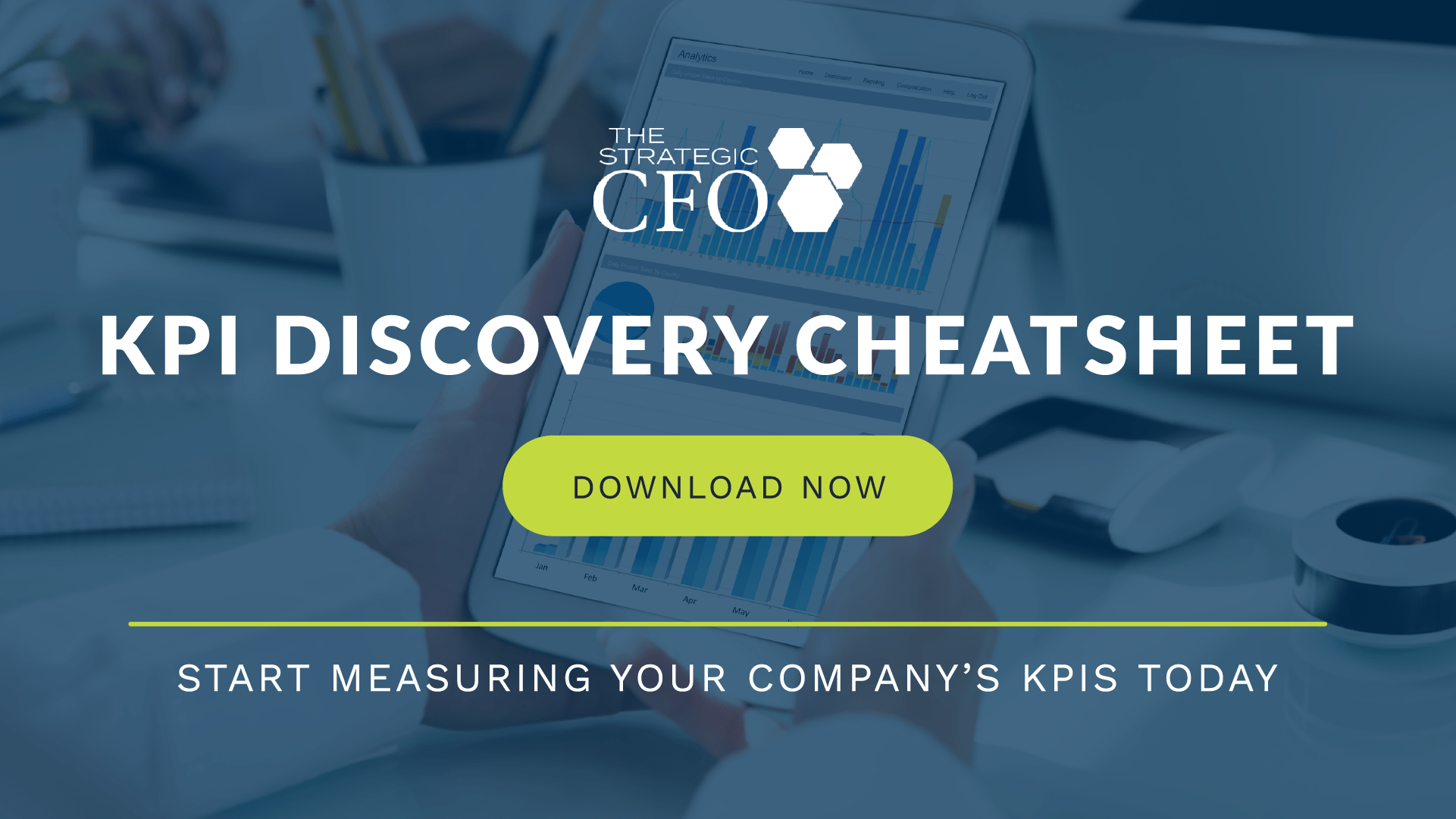
This past week, one of my clients met with a
banker to develop a new banking
relationship. He hands the banker the company’s
financial statements, expecting the banker to look at the
income statement. Instead, the banker flips to the back of the
financial statements to look over the
balance sheet. As the coach, I asked my client, “See what he just did?” Most
financial leaders (and the owners of their businesses) are consumed with their income statement but the
banks want to know are more interested in how leveraged their
banking client is. Not surprisingly, there are a few key elements when seeking
financing for companies to follow.
Key Elements When Seeking Financing
Every company cycles through good and bad times. Depending on what part of the
cycle your company is currently in, your
banking relationship may be influenced. There are some key elements when seeking
financing that will keep you on the good side of your banker.
[highlight]Identifying your KPIs is a critical piece of the process when seeking financing. Want to find your KPIs and learn how to track them? Access your free
KPI Discovery Cheatsheet today![/highlight]
Leverage
What is leverage? Financial leverage is the use of borrowing from the bank to offset the cost of sales. Many companies hope to borrow just enough to increase their capabilities to sell more. But if banks see that you are too highly-leveraged, it’s bad news!
As a key element when seeking financing, leverage is important to have as it provides credibility to your borrowing experience. A banker will see that you have maximized the potential of previous capital to increase sales. The “kicker” here is if you have failed to optimize the borrowed capital potential, then the bank is going to be more prone to backing out of (or not starting in the first place) a banking relationship with you.
Cash Flow
We say it often and we say it loud… Cash is king. Without cash and/or liquid assets in your company, the bank is going to turn its nose up at you. Be sure to communicate the availability of cash in your company. For example, if a friend asked you for $250,000 but had no way of paying you back, you would be wary and decline the ask. This is because there is no hope that you will get the money back that you loaned. The bank acts in its best interest.
Make it easy for the bank to make a decision. Communicate through the financial statements (especially the balance sheet) the availability of cash.
Not About Price
Oftentimes, business leaders think that the bank cares about the price of your product. They don’t. To the bank, price is the least important factor in their assessment of your company because money is a commodity to them. Price is immaterial.
When meeting with a banker, communicate the bottom line and what’s on the financial statements NOT how you price your product. The bank is not your business consultant. They have to make money off of you.
Creating a Banking Relationship
When seeking financing, it is essential to create a banking relationship. You wouldn’t get married to the person you passed by on the sidewalk, so why would you get into a banking relationship with someone you have zero connection with. There are a few things that you need to look for to have a successful banking relationship.
What to Look For
If you are just starting out in a new city or have no relationships with any bankers, one of the first things that you can do is connect with people that do! For example, as a consultant, I have multiple relationships with various
banks. When one of my clients needs a
banker, I make the connection. People love feeling like they have it all, so give them the benefit and ask for help.

Look at the bank for their philosophy and how they take care for their customers. In addition to philosophy, look at their morals.
Some questions to ask your banker in the “dating” stage include:
- How long is a typical relationship with your customers?
- What are the communication boundaries?
- What is the bank’s view of breaking debt covenants?
Relationship or Transaction
Another important question you need to ask yourself is: “is this bank looking for a relationship or a transaction?” If you answer the latter, then you are just commission to them. When times are rough, you’re going to get cut. But if the answer is a relationship, then you’re looking at a long healthy marriage.
Relationships are absolutely critical in business. Value these relationships and take care of people. It will reflect in your business.
How does the bank deal in times of crisis?
A few years ago, I had a client that went through a period of stress. In the last quarter of their fiscal year, the business was growing and was doing well. They had 4 quarters of decline, but had tracked their KPIs. Although they had broken a few
debt covenants, they were tracking their progress carefully with the bank. This client had a strong relationship with their bank. Without that relationship, the bank would have taken my client to the
“workout” group.
When you stub your toe, how does your bank react? Are they willing to let you slide on debt covenants for a few quarters as long as you have a
plan to get out of the downturn? Often, people don’t see the importance of knowing how your bank is going to react in times of
crisis. The
economy continually ebbs and flows, changing for good or for bad.
Also, how does the bank deal with growth? You need more financing, but you are breaking covenants. Are they willing to
provide financing with the knowledge that things won’t pick up immediately?
The Workout Group
Several years ago, the bank wanted to meet with another of my clients because they had broken their
debt covenants. The client calls me after meeting with “great news”! He said that the Bank had offered to work out his problems in the workout group. This “workout” group isn’t to work out your problems and put you back on track. It’s to work you out of the bank. This is not a good thing.
You don’t think your house will ever burn down, but what happens if your house does burn down? You don’t think you need a bank to weather the storm, but what happens when you need the bank to weather the storm with you? Assess whether or not your current
banking relationship will be your
insurance in the case of a fire or storm.
One way to do this is to look at the bank’s philosophy of business and their internal culture. How tight are they with the rules? Are they willing to stretch a little on their
debt covenants and step up to help in times of distress? My client’s bank was unwilling to stretch its debt covenants. Instead the bank just wanted to wipe their hands clean of my client and move on to the next sale.
This willingness to be
flexible all boils down to relationships. I have to warn you though, not every bank is similar in their goals.
 Get in Line
Get in Line
To prevent being put into the “workout” group, it’s crucial to start out on the same page. Get an alignment of interests, philosophies, culture, and anything else that would impact your company.
Interest and Philosophies
If the bank is only interested in their bottom line, then it may not be a good fit. If the bank is truly invested in your company and is willing to help you out in any reasonable way, then it’s a perfect match.
As I’ve built The Strategic CFO, it’s been a priority of mine to create relationships with bankers as they are going to reap the benefits of my clients doing business with them and I value their expertise. As a result of our
mutual interests, the bankers in my
network continually push potential clients towards my consulting practice. Those bankers and I have a strong relationship where we understand each others’ needs and desires as well as feed each other.
Of course though, I have had bankers tried to take advantage of my generosity and not return the favor. As a result, those relationships did not last long. It’s all about getting ones’ interests and
philosophies in line.
KPIs That Influence Debt Covenants
Banks monitor your debt covenants. To help them (and you) out, identify
KPIs that influence debt covenants to help
track where you are and where you’re going. Picture this, your significant other or spouse comes home and lets you know that they’ve purchased a house, car, and boat without ever discussing it with you before. If you’re like me, I’d be surprised and would want to control the situation. If your significant other continues to make extravagant purchases or
decisions without your prior knowledge, you would have
trust issues and may want to cut up their credit card while they’re sleeping.
People see banking relationships as far-off and a different type of relationship. But the truth is, it’s all the same. Relationships are relationships. If you or your company or your significant other continues to create negative surprises, it’s not going to help with the relationship.
First,
fix the problem before it becomes an issue. As soon as you see a yellow flag, jump on it!
Then after you fix it, let your bank know what has happened and how it has been
resolved. This not only comforts the bank but builds
trust. If the yellow flag starts turning red, alert the bank and outline the consequences. This helps you prepare and for the bank to
prepare. Procrastinating this step can result in devastating consequences. The bank may be able to help you if you give them enough time.
Start identifying and tracking those KPIs that influence your debt covenants. For help and tips on how we measure KPIs, download our
KPI Discovery Cheatsheet today! Know your numbers and where your company is the weakest so that you can start turning around your future.

Strategic CFO Lab Member Extra
Access your Flash Report Execution Plan in SCFO Lab. The step-by-step plan to create a dashboard to measure productivity, profitability, and liquidity of your company.
Click here to access your Execution Plan. Not a Lab Member?
Click here to learn more about SCFO Labs


 Look at the bank for their philosophy and how they take care for their customers. In addition to philosophy, look at their morals.
Look at the bank for their philosophy and how they take care for their customers. In addition to philosophy, look at their morals. Get in Line
Get in Line











